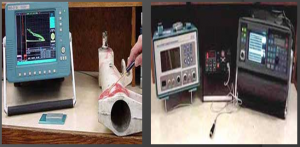Eddy Current Inspection
NDT and Eddy Current Testing:
NDT allows parts and materials to be inspected and measured without damaging them. Because it allows inspection without interfering with a product’s final use, NDT provides an excellent balance between quality control and cost-effectiveness.
 Nondestructive testing method categories:
Nondestructive testing method categories:
Ultrasonic testing (UT)
Radiography X-ray
Electromagnetic testing (ET)
Eddy-Current Testing (ECT).
Visual inspection (VT)
Pipeline video inspection
Used in :
crack detection & other discontinuities include porosity, wall thinning from corrosion and many sorts of disbonds.
Basic Principles of Eddy Current Inspection:
Eddy current inspection is one of several NDT methods that use the principal of “electromagnetism” as the basis for conducting examinations.
Eddy currents are created through a process called electromagnetic induction. When alternating current is applied to the conductor, such as copper wire, a magnetic field develops in and around the conductor.
If another electrical conductor is brought into the close proximity to this changing magnetic field, current will be induced in this second conductor.
Eddy Current:
Eddy currents are induced electrical currents that flow in a circular path.
Applications :
- Crack detection
- Material thickness measurements
- Coating thickness measurements
- Conductivity measurements
Eddy current inspection :
crack detecting
Eddy current inspection is an excellent
Method for detecting surface and near
Surface Defects when the probable defect location and orientation is well known.
Advantages of Eddy current inspection:
Sensitive to small cracks and other defects
- Inspection gives immediate results
- Equipment is very portable
- Test probe does not need to contact the part
• Inspects complex shapes and sizes of conductive materials
 limitation of eddy current inspection:
limitation of eddy current inspection:
- Only conductive materials can be inspected
- Surface must be accessible to the probe
- Skill and training required is more extensive than other techniques
- Depth of penetration is limited



